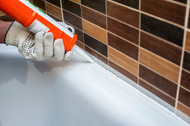Using Sealant for Tile Waterproofing
Sep 11th 2024
Tiles are beautiful, sturdy, and offer a way to bring creativity and an artistic flair to any space! However, if the seal isn’t sturdy, it can turn ugly – both aesthetically and financially.
Repairing tile can end in a complete replacement of the tile itself, and one or more layers of the building substrate underneath, which can get expensive fast. You should always make sure you install and waterproof tile correctly so it can last for years to come.
Why Use Silicone In Tile Jobs?
From home showers to tile floors in grocery stores, tile and grout need protection from wear, tear, and the elements that come with foot traffic and daily use. Applying a good-quality 100% RTV silicone sealant after allowing the grout to dry completely will prevent water damage, dirt, and staining.
Silicone as a Tile Waterproofer
Silicone's waterproofing ability truly shines when working with tile. Water is the nemesis of unsealed grout, causing it to stain and crumble. As the grout cracks, water will begin seeping into the underlayment materials beneath. Eventually mold and rot can spread under the tile, leading to more extensive (and expensive) repairs.
You usually don’t need to seal ceramic tiles, but natural stone tiles of all kinds are porous. These tiles benefit from sealing because water, oils, and dirt will stain them over time. Sealing natural tiles protects the beauty and integrity of your stone tiles for a lifetime.
Where to Use Silicone Tile Sealant
After the tiles are laid and the grout is fully cured, it’s time to decide whether you want to use a 100% RTV silicone sealant or if you'd rather opt for a specifically formulated tile and grout sealer.
At a minimum, though, consider using silicone in these locations:
- the crack between walls and floor tile.
- around toilets.
- around sinks.
- alongside showers and tubs.
- any seams or corners inside showers or tubs.
- around faucets.
- around the edges of backsplashes.
- around windows.
- along door thresholds.
- Anywhere else that water may seep in, leak, or puddle up.
Tile that's installed in areas that often get wet, like bathrooms and kitchens, need an extra layer of protection. We recommend choosing a product that's mold and mildew resistant, in addition to silione's natural waterproofing properties.
A great choice for this is our highly-rated Kitchen and Bath Mildew Resistant RTV Silicone Sealant. This clear silicone sealant is smooth and easy to apply, and will maintain its clean, fresh look while protecting your tilework for many years.
Tips for Applying Silicone Tile Sealant
If you've decided silicone is the best choice for your tile project, follow these application process tips to ensure you get a smooth, snug seal that won't peel or crack.
Prep the Surface
First, make sure everything else has completely cured and dried. Then, clean all the tile surfaces, and vacuum up all dust and grout residue. This ensures the RTV silicone will fully bond to the surfaces you need to seal.
Tape Off Edges to Ensure Clean Lines
Using masking tape to control excess silicone is especially helpful for two reasons.
- Silicone can stick to most surfaces and is hard to remove after about 15 minutes.
- Tape can help you get a clean, fully filled seal to prevent cracks and water seepage.
You Can Rely On Silicone
Silicone makes a fantastic, waterproof tile sealant that will last for many years without molding, yellowing, or breaking down. If you need help choosing the right silicone sealant for your next project, give us a call at 812-824-8000.

